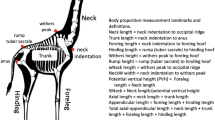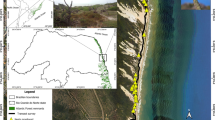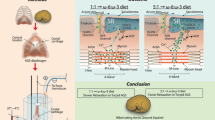Abstract
Mammalian hibernators undergo dramatic seasonal changes of food intake and the use of their gastrointestinal tract. During several months of hibernation fat-storing hibernators do not use their intestinal tract for nutritional intake. However, during the rest of the year they have to increase their energy intake in order to compensate high reproductive investment and store sufficient body fat to survive the following hibernation period. Edible dormice (Glis glis) are obligate fat-storing hibernators which hibernate in Germany from September until June. Males incur high energetic costs during mating and as soon as reproduction is terminated they have to accumulate high quantities of fat to survive hibernation. In order to understand how fat-storing hibernators like edible dormice cope with these energetically demanding situations, we measured body mass changes of captured male edible dormice in the field and studied their feeding ecology. Furthermore, we measured seasonal changes in food ingestion and assimilation rates by feeding experiments carried out in captivity.
Results of this study revealed that during the mating season males significantly lowered their body mass, while food ingestion and assimilation rates remained constant. The body mass reduction showed that they used their body fat reserves to pay at least part of the energetic costs of reproduction. During the pre-hibernation fattening period males increased their body mass but held their assimilation rates on a constant level. Nevertheless, they increased the amount of ingested food and subsequently the amount of energy intake. Furthermore, they changed their dietary spectrum in the field by turning to lipid-rich seeds. These behavioral adaptations enable them to restore their energy losses during reproduction and to accumulate sufficient body fat to survive hibernation.
Similar content being viewed by others
References
Armitage, K.B., 1979. Food selectivity by yellow-bellied marmots. J. Mammal. 60, 628–629.
Bairlein, F., 1985. Efficiency of food utilization during fat deposition in the long-distance migratory garden warbler, Sylvia borin. Oecologia 68, 118–125.
Bairlein, F., 1987. Nutritional requirements for maintenance of body weight and fat deposition in the long-distance migratory garden warbler, Sylvia borin (Boddaert). Comp. Biochem. Physiol. A Comp. Physiol. 86, 337–347.
Bieber, C., 1998. Population dynamics, sexual activity, and reproduction failure in the fat dormouse (Myoxus glis). J. Zool. Lond. 244, 223–229.
Bieber, C., Ruf, T., 2004. Seasonal timing of hibernation and reproduction in the edible dormouse (Glis glis). In: Barnes, B., Carey, H. (Eds.), Life in the Cold: Evolution, Mechanisms, Adaptation, and Application. Twelfth Hibernation Symposium, Fairbanks, Alaska, USA, pp. 113–125.
Cant, J.P., McBride, B.W., Croom, W.J.J., 1996. The regulation of intestinal metabolism and its impact on whole animal energetics. J. Anim. Sci. 74, 2541–2553.
Carey, H.V., 1990. Seasonal changes in mucosal structure and function in ground squirrel intestine. Am. J. Physiol. 259, R385–R392.
Carey, H.V., 1992. Effects of fasting and hibernation on ion secretion in ground squirrel intestine. Am. J. Physiol. 263, 1202–1208.
Carey, H.V., 2005. Gastrointestinal responses to fasting in mammals: lessons from hibernators. In: Strarck, J.M., Wang, T. (Eds.), Physiological and Ecological Adaptations to Feeding in Vertebrates. Science Publishers, New Hampshire, pp. 229–254.
Clutton-Brock, T.H., Harvey, P.H., 1978. Mammals, resources and reproductive strategies. Nature 273, 191–195.
Clutton-Brock, T.H., Albon, T.H., Gibson, S.D., Guiness, F.E., 1979. The logical stag: adaptive aspects of fighting in red deer (Cervus elaphus L.). Anim. Behav. 27, 211–225.
Clutton-Brock, T.H., Albon, S.D., Guinness, F.E., 1989. Fitness costs of gestation and lactation in wild mammals. Nature 337, 260–262.
Danell, K., Bergström, R., 2002. Mammalian herbivory in terrestrial environments. In: Herrera, C.M., Pellmyr, O. (Eds.), Plant-Animal Interactions: an Evolutionary Approach. Blackwell Science, Oxford, pp. 107–131.
Drozdz, A., 1968. Digestability and assimilation of natural foods in small rodents. Acta Theriol. 13, 367–389.
Fietz, J., Ganzhorn, J.U., 1999. Feeding ecology of the hibernating primate Cheirogaleus medius: how does it get so fat? Oecologia 121, 157–164.
Fietz, J., Schlund, W., Dausmann, K.H., Regelmann, M., Heldmaier, G., 2004. Energetic constraints on sexual activity in the male edible dormouse (Glis glis). Oecologia 138, 202–209.
Fietz, J., Pflug, M., Schlund, W., Tataruch, F., 2005. Influences of the feeding ecology on body mass and possible implications for reproduction in the edible dormouse (Glis glis). J. Comp. Physiol. B 175, 45–55.
Frank, C.L., 1992. The influence of dietary fatty acids on hibernation by golden-mantled ground squirrels (Spermophilus lateralis). Physiol. Zool. 65, 906–920.
Frank, C.L., 1994. Polyunsaturate content and diet selection by ground squirrels (Spermophilus lateralis). Ecology 75, 458–463.
Frank, C.L., 2002. Short-term variations in diet fatty acid composition and torpor by ground squirrels. J. Mammal. 83, 1013–1019.
Frank, C.L., Dierenfeld, E.S., Storey, K.B., 1998. The relationship between lipid peroxidation, hibernation, and food selection in mammals. Am. Zool. 38, 341–349.
Ganzhorn, J.U., Klaus, S., Ortmann, S., Schmid, J., 2003. Adaptations to seasonality: some primate and nonprimate examples. In: Kappeler, P.M., Pereira, M.E. (Eds.), Primate Life Histories and Sociobiology. University of Chicago Press, Chicago, pp. 132–148.
Geiser, F., Kenagy, G.J., 1993. Dietary fats and torpor patterns in hibernating ground squirrels. Can. J. Zool. 71, 1182–1185.
Gigirey, A., Rey, J.M., 1999. Faecal analysis of the edible dormouse (Glis glis) in the northwest Iberian Peninsula. Z. Säugetierkunde 64, 376–379.
Gross, J.E., Wang, W., Wunder, B.A., 1985. Effects of food quality and energy needs: changes in gut morphology and capacity of Microtus ochrogaster. J. Mammal. 66, 661–667.
Harlow, H.J., Frank, C.L., 2001. The role of dietary fatty acids in the evolution of spontaneous and facultative hibernation patterns in prairie dogs. J. Comp. Physiol. B 171, 77–84.
Heldmaier, G., Elvert, R., 2004. How to enter torpor: thermodynamic and physiological mechanisms of metabolic depression, Life in the Cold: Evolution, Mechanisms, Adaptation, and Application. 12th International Hibernation Symposium, pp. 185–198.
Heldmaier, G., Neuweiler, G., 2004. Vergleichende Tierphysiologie. Springer, Berlin, Heidelberg.
Heldmaier, G., Ruf, T., 1992. Body temperature and metabolic rate during natural hypothermia in endotherms. J. Comp. Physiol. B Biochem. Syst. Environ. Physiol. 162, 696–706.
Hume, I.D., Beiglböck, C., Ruf, T., Frey-Roos, F., Bruns, U., Arnold, W., 2002. Seasonal changes in morphology and function of the gastrointestinal tract of free-living alpine marmots (Marmota marmota). J. Comp. Physiol. B 172, 197–207.
Jallageas, M., Assenmacher, I., 1983. Annual plasma testosterone and thyroxine cycles in relation to hibernation in the edible dormouse Glis glis. Gen. Comp. Endocrinol. 50, 452–462.
Jönsson, K.I., Tuomi, J., Jaremo, J., 1998. Pre- and postbreeding costs of parental investment. Oikos 83, 424–431.
Kager, T., 2004. Energetische Kosten der Reproduktion bei freilebenden Siebenschläfern (Glis glis L.). In Biology. University of Ulm, Ulm.
Kuenkele, J., Kenagy, G.J., 1997. Inefficiency of lactation in primiparous rats: the costs of first reproduction. Physiol. Zool. 70, 571–577.
Lyman, C.P., Willis, J.S., Malan, A., Wang, L.C.H., 1982. Hibernation and Torpor in Mammals and Birds. Academic Press, London.
McElligot, A.G., Naulty, F., Clarke, W.V., Hayden, T.J., 2003. The somatic cost of reproduction: what determines reproductive effort in prime-aged fallow bucks? Evol. Ecol. Res. 5, 1–12.
Melnyk, R.B., 1978. Persistence of body weight cycles in dormice maintained with a limited food supply. Experientia 35, 603–604.
Melnyk, R.B., 1981. Insulin-induced feeding in hibernators. Behav. Neural Biol. 32, 70–78.
Millar, J.S., 1979. Adaptive features of mammalian reproduction. Evolution 31, 370–386.
Millesi, E., Huber, S., Walzl, M., Dittami, J.P., 2000. Follicular development and hibernation in European ground squirrels. In: Heldmaier, G., Klingenspor, M. (Eds.), Life in the Cold: Eleventh International Hibernation Symposium. Springer, Heidelberg, pp. 285–292.
Morris, P.A., Hoodless, A., 1992. Movements and hibernaculum site in the fat dormouse (Glis glis). J. Zool. Lond. 228, 685–687.
Mrosovsky, N., 1966. Acceleration of annual hibernating cycles to 6 weeks in captive dormice. Can. J. Zool. 44, 903–910.
Mrosovsky, N., Melnyk, R.B., Lang, K., Hallonquist, J.D., Boshes, M., Joy, J.E., 1980. Infradian cycles in dormice (Glis glis). J. Comp. Physiol. A 137, 315–339.
Pereira, M.E., 1993. Seasonal adjustment of growth rate and adult body weight in ringtailed lemurs. In: Kappeler, P.M., Ganzhorn, J.U. (Eds.), Lemurs Social Systems and their Ecological Basis. Plenum Press, New York, pp. 205–222.
Pereira, M.E., Strohecker, R.A., Cavigelli, S.A., Hughes, C.L., Pearson, D.D., 1999. Metabolic strategy and social behavior in lemuridae. In: Rakotosamimanana, B., Rasaminanana, H., Ganzhorn, J.U. (Eds.), New Directions in Lemur Studies, New York, pp. 93–118.
Petter-Rousseaux, A., Hladik, C.M., 1980. A comparative study of food intake in five nocturnal prosimians in simulated climatic conditions. In: Charles-Dominique, P., Cooper, H.M., Hladik, A., Hladik, C.M., Pages, E., Pariente, G.F., Petter-Rousseaux, A., Petter, J.-J., Schilling, A. (Eds.), Nocturnal Malagasy Primates: Ecology, Physiology and Behaviour. Academic Press, New York, pp. 169–179.
Piersma, T., Lindström, A., 1997. Rapid and reversible changes in organ size as a component of adaptive behaviour. Trends Ecol. Evol. 12, 134–138.
Pilastro, A., Tavecchia, G., Marin, G., 2003. Long living and reproduction skipping in the fat dormouse. Ecology 84, 1784–1792.
Ruf, T., Fietz, J., Schlund, W., Bieber, C., 2006. High survival in poor years: life history tactics adapted to mast seeding in the edible dormouse. Ecology 87, 372–381.
Sawicka-Kapustra, K., Dobrotecka, M., Drozdz, A., Tertil, R., 1975. Bioenergetic parameters of experimental groups of common voles (Microtus arvalis) Ekologia Polska 23, 347–365.
Schauer, S., 2007. Energetische Kosten der Reproduktion bei männlichen Siebenschläfern (Glis glis L.). Diploma Thesis in Biology. University of Ulm, Ulm.
Schlund, W., 1996. Vergleich von Siebenschläferpopulationen (Myoxus glis L.) in zwei unterschiedlichen Waldhabitaten: Einfluss von Habitatqualität auf Populationsstruktur, Morphologie und Reproduktion von Siebenschläfern. PhD Thesis, Eberhard-Karls University, Tübingen
Schlund, W., 2005. Siebenschläfer Glis glis (Linnaeus, 1766). In: Braun, M., Dieterlen, F. (Eds.), Die Säugetiere Baden-Württembergs, vol. 2. Ulmer GmbH & Co., Stuttgart, pp. 199–210.
Sibly, R.M., 1981. Strategies of Digestion and Defecation. Blackwell, Oxford.
Simmen, B., Hladik, C.M., 1988. Seasonal variation of taste threshold for sucrose in a prosimian species, Microcebus murinus. Folia Primatol. 51, 152–157.
Simmen, B., Josseaume, B., Atramentowicz, M., 1999. Frugivory and taste responses of fructose and tannic acid in a prosimian primate and didelphid marsupial. J. Chem. Ecol. 25, 331–346.
Simons, D., Bairlein, F., 1990. Neue Aspekte zur zugzeitlichen Frugivorie der Gartengrasmücke (Sylvia borin). J. Ornithol. 131, 381–401.
Speakman, J.R., Gidney, A., Bett, J., Mitchell, I.P., Johnson, M.S., 2001. IV. Effect of variation in food quality on lactating mice Mus musculus. J. Exp. Biol. 204, 1957–1965.
Speller, S.W., 1972. Biology of Dicrostonyx groenlandicus on Truelove Lowland, Devon Island. University of Alberta, Edmonton, pp. 257–271.
SPSS, I., 2004. SPSS Base 8.0 for Windows User’s Guide. SPSS Inc., Chicago, IL.
Starck, J.M., 2005. Structural flexibility of the digestive system of tetrapods-patterns and processes at the cellular and tissue level. In: Starck, J.M., Wang, T. (Eds.), Physiological and Ecological Adaptations to Feeding in Vertebrates. Science Publishers, New Hampshire, pp. 175–200.
Stevens, C.E., Hume, I.D., 1995. Comparative Physiology of the Vertebrate Digestive System. Cambridge University Press, Cambridge.
Totzke, U., Hubinger, A., Dittami, J., Bairlein, F., 2000. The autumnal fattening of the long-distance migratory garden warbler (Sylvia borin) is stimulated by intermittent fasting. J. Comp. Physiol. B Biochem. Syst. Environ. Physiol. 170, 627–631.
Vietinghoff-Riesch, A., 1960. Der Siebenschläfer (Glis glis L.). Jena, Gustav Fischer.
Vogt, F.D., Lynch, G.R., 1982. Influence of ambient temperature, nest availability, huddling and daily torpor on energy expenditure in the white-footed mouse, Peromyscus leucopus. Physiol. Zool. 55, 56–63.
Weiner, J., 1987. Maximum energy assimilation rates in the Djungarian hamster (Phodopus sungorus). Oecologia 72, 297–302.
White, T.C.R., 2002. Outbreaks of house mice in Australia: limitation by a key resource. Aust. J. Agric. Res. 53, 505–509.
Wilz, M., Heldmaier, G., 2000. Comparison of hibernation, estivation and daily torpor in the edible dormouse, Glis glis. J. Comp. Physiol. B 170, 511–521.
Wolff, J.O., 1998. Breeding strategies, mate choice, and reproductive success in American bisons. Oikos 83, 529–544.
Woods, B.C., Armitage, K.B., 2003. Effect of food supplementation on juvenile growth and survival in Marmota flaviventris. J. Mammal. 84, 903–914.
Zoufal, K., 2005. Energiehaushalt des Siebenschläfers (Glis glis) während der Jungenaufzucht. Diploma Thesis in Naturwissenschaften und Mathematik, Vienna, Vienna, p. 49.
Author information
Authors and Affiliations
Corresponding author
Rights and permissions
About this article
Cite this article
Sailer, M.M., Fietz, J. Seasonal differences in the feeding ecology and behavior of male edible dormice (Glis glis). Mamm Biol 74, 114–124 (2009). https://doi.org/10.1016/j.mambio.2008.05.005
Received:
Accepted:
Published:
Issue Date:
DOI: https://doi.org/10.1016/j.mambio.2008.05.005




